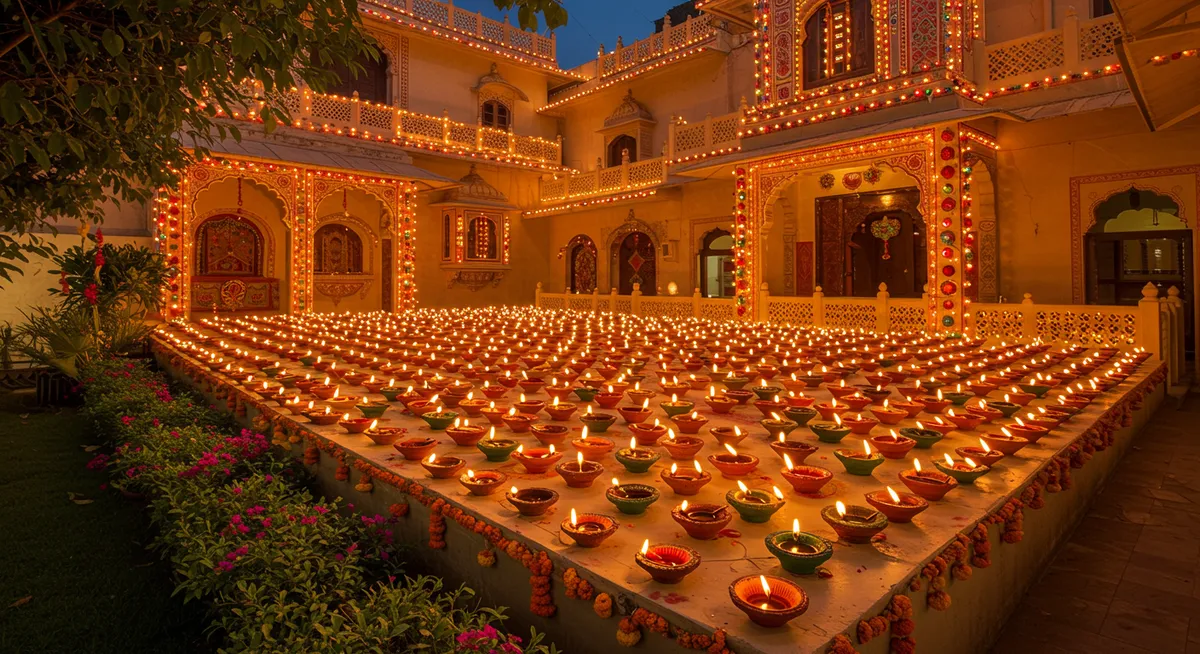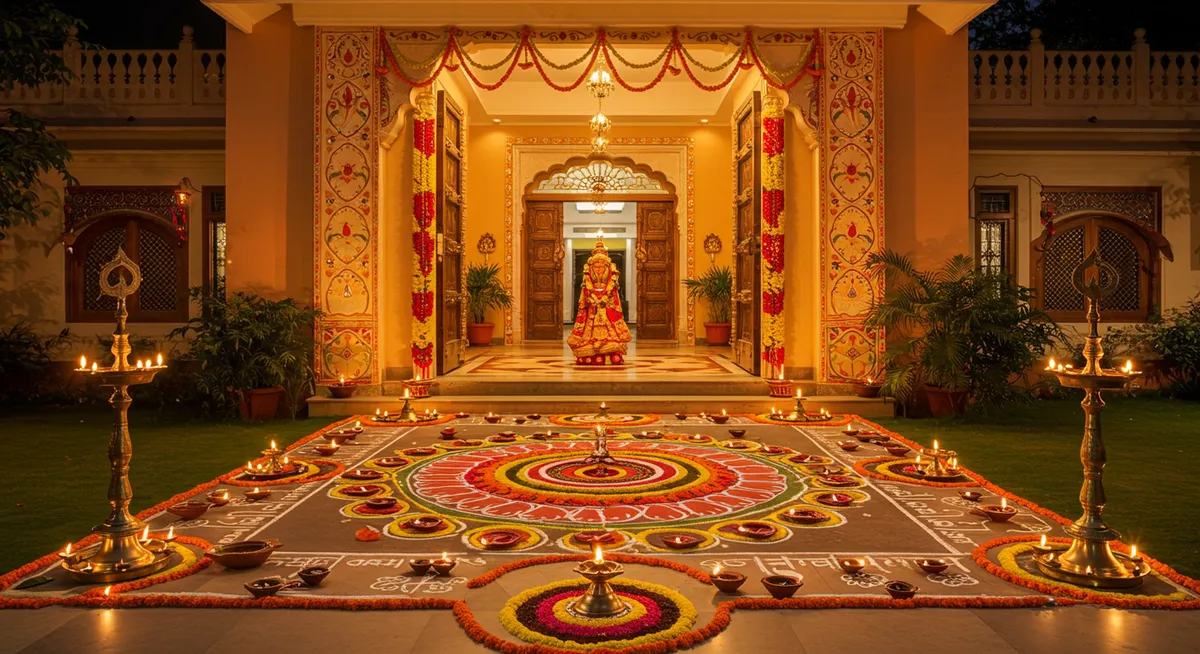Diwali Festival Guide | India's Spectacular Celebration of Light

Diwali: India's Magnificent Festival of Lights and New Beginnings
For five extraordinary days each autumn, the Indian subcontinent transforms into a spectacular pageant of light and celebration as millions of homes, temples, and public spaces illuminate with the warm glow of countless oil lamps and electric lights. Diwali (or Deepavali), often described as the Festival of Lights, represents India's most universally beloved celebration—a time when families gather, communities unite, and the symbolic triumph of light over darkness, knowledge over ignorance, and good over evil is joyously commemorated. From humble clay lamps on village doorsteps to elaborate light displays in urban centers, Diwali's radiance reflects a cultural heritage dating back thousands of years while continuously evolving in the modern world. This guide explores the rich traditions, spiritual significance, and diverse regional expressions of this magnificent festival that illuminates the heart of Indian civilization.

The Spiritual Significance of Diwali
Beyond its spectacular visual displays, Diwali embodies profound spiritual and philosophical concepts:
- Light Symbolism: The illumination of lamps represents the victory of inner light over spiritual darkness
- New Beginnings: Celebrated as the start of a new year in many Indian calendrical traditions
- Prosperity Invitation: Rituals to welcome Lakshmi, the goddess of wealth and abundance
- Spiritual Homecoming: Celebration of divine presence and the soul's journey toward enlightenment
- Universal Values: The triumph of righteousness (dharma) over unrighteousness (adharma)
Ancient Origins and Mythological Connections
Diwali's origins interweave multiple sacred narratives and historical elements:
The Return of Lord Rama
In North India, Diwali primarily commemorates this epic journey:
- Ramayana Connection: Celebrates Lord Rama's victorious return to Ayodhya after 14 years of exile
- The First Illumination: Citizens lit oil lamps to guide Rama, Sita, and Lakshmana home
- Symbolic Victory: Represents the triumph of virtue after Rama's defeat of the demon king Ravana
- Royal Coronation: Marks Rama's ascension to the throne and the establishment of Rama-rajya (ideal rule)
Other Divine Associations
Different regions connect Diwali to various deities and stories:
- Krishna Tradition: In some regions, celebrates Krishna's victory over the demon Narakasura
- Lakshmi Worship: Honors the birth of Lakshmi, goddess of prosperity, from the cosmic ocean
- Kali Connection: In Bengal, associated with worship of the goddess Kali
- Vishwakarma Veneration: Day when craftspeople honor the divine architect Vishwakarma
- Jain Significance: Marks the attainment of moksha by Lord Mahavira, the founder of Jainism

The Five-Day Festival Sequence
Diwali unfolds as a carefully structured celebration with distinct phases:
Dhanteras (Day 1)
The festival begins with this auspicious day focused on prosperity:
- Metal Purchases: Tradition of buying gold, silver, or kitchen utensils as symbols of good fortune
- Yama Deepam: Special lamp lit to ward off untimely death, honoring the story of King Hima
- Home Cleansing: Thorough cleaning and decoration of homes begins
- Lakshmi Prayers: Initial invocations to the goddess of wealth
Naraka Chaturdashi or Choti Diwali (Day 2)
The second day focuses on the victory of light over darkness:
- Ritual Bathing: Early morning bath with special oils to remove impurities
- Krishna Celebration: Commemorates Lord Krishna's victory over the demon Narakasura
- Rangoli Creation: Elaborate decorative patterns created at home entrances
- Final Preparations: Completion of home decorations and preparation of sweets and gifts
Lakshmi Puja (Day 3)
The main day of Diwali represents the festival's pinnacle:
- Goddess Invocation: Formal prayers to Lakshmi and Ganesha in homes and temples
- Illumination: Lighting of oil lamps throughout homes and communities
- Fireworks Display: Traditional fireworks and sparklers illuminate the night sky
- Family Feast: Elaborate meal featuring special Diwali delicacies
- Gift Exchange: Sharing of presents, sweets, and good wishes among friends and family
Govardhan Puja or Padwa (Day 4)
The fourth day varies by region with distinctive traditions:
- Krishna Commemoration: North Indians celebrate Krishna's protection of villagers from floods
- New Year Observance: Marks the beginning of the new year in many Hindu calendars
- Marital Celebration: Honors the bond between husband and wife in some communities
- Cow Worship: Agricultural communities perform rituals honoring cattle
Bhai Dooj (Day 5)
The festival concludes with a celebration of familial bonds:
- Sibling Celebration: Brothers visit sisters' homes to receive blessing and hospitality
- Protective Rituals: Sisters perform ceremonies for brothers' well-being and prosperity
- Gift Giving: Brothers traditionally present gifts to their sisters
- Shared Meals: Special feast celebrating family unity
Regional Expressions of Diwali
While sharing common elements, Diwali displays remarkable regional diversity:
North India
The heartland of traditional Diwali celebration:
- Ramayana Focus: Strong emphasis on Lord Rama's return to Ayodhya
- Elaborate Lighting: Particularly ornate displays of diyas and electric lights
- Ram Lila Performances: Dramatic reenactments of scenes from the Ramayana
- Gambling Tradition: Card games played to invoke Parvati's blessing, based on mythology
- Regional Sweets: Distinctive confections like kaju katli, gulab jamun, and besan ladoo
South India
Distinctive southern traditions with unique elements:
- Oil Bath Ritual: Dawn bathing with special herbal oils before celebrations
- Krishna Emphasis: Greater focus on Krishna's victory over Narakasura
- Naraka Chaturdashi Prominence: Often more significant than Lakshmi Puja day
- Distinctive Sweets: Regional specialties like mysore pak, payasam, and boondi ladoo
- Early Morning Celebration: Pre-dawn festivities rather than evening emphasis

West India
Gujarat and Maharashtra feature vibrant regional customs:
- New Year Significance: Celebrated as the beginning of the Gujarati New Year
- Annakut Festival: Mountain of food offerings presented to Krishna
- Faral Foods: Maharashtrian savory snacks prepared specifically for the festival
- Lakshmi Footprints: Small footprints drawn with vermilion powder to welcome the goddess
- Commercial New Year: Businesses start new accounting books on this auspicious day
East India
Eastern regions emphasize distinctive goddess worship:
- Kali Puja: In Bengal, worship of the goddess Kali takes precedence
- Shyama Puja: Midnight ritual offerings to the dark goddess
- Cattle Decoration: In Odisha, elaborately adorned cattle are worshipped
- Tribal Variations: Indigenous communities incorporate traditional elements
- Special Rice Dishes: Distinctive festive preparations featuring local rice varieties
Diwali Beyond India
The festival has spread globally through diaspora communities:
- Nepal: Celebrated as Tihar with distinctive animal worship elements
- Singapore and Malaysia: Major public celebrations in Little India districts
- Trinidad and Fiji: National holidays with distinctive Indo-Caribbean traditions
- Global Cities: Growing recognition with public events in London, New York, and Sydney
- Diplomatic Recognition: Official celebrations at the White House and other international venues
Essential Diwali Traditions
Several key practices define the festival experience:
Illumination
Light serves as the festival's defining element:
- Traditional Diyas: Small clay lamps filled with ghee or oil and cotton wicks
- Modern Lighting: Electric light strings and elaborate displays
- Symbolic Placement: Strategic positioning of lamps to guide Lakshmi into homes
- Fireworks Displays: Ranging from simple sparklers to elaborate pyrotechnics
- Community Illumination: Public buildings and spaces decorated with light installations
Artistic Traditions
Visual arts play a central role in celebration:
- Rangoli: Intricate floor designs created with colored powders, flowers, and rice
- Torana: Decorative door hangings made from mango leaves and marigolds
- Alpana: Bengali rice-paste floor decorations with distinctive patterns
- Home Adornment: Marigold garlands, banana leaves, and symbolic decorations
- Ritual Art: Creation of sacred symbols and yantra patterns for worship
Culinary Traditions
Special foods mark the celebratory atmosphere:
- Mithai: Elaborate sweet preparations using milk, sugar, nuts, and spices
- Namkeen: Savory snacks like chakli, mathri, and mixture
- Festive Meals: Special dinner preparations featuring regional specialties
- Food Gifting: Exchange of homemade or specialty sweets in decorative boxes
- Charitable Feeding: Tradition of sharing food with those less fortunate
Social and Cultural Dimensions
Beyond religious observance, Diwali serves important social functions:
Family and Community Bonds
The festival strengthens social connections:
- Family Reunions: Major travel period as people return to ancestral homes
- Home Visits: Tradition of visiting friends and relatives with gifts
- Community Celebrations: Neighborhood events and shared festivities
- Reconciliation: Traditional time to resolve conflicts and renew relationships
- Cross-Cultural Sharing: Increasingly celebrated across religious boundaries in India
Economic Significance
Diwali generates substantial economic activity:
- Shopping Season: Major retail period comparable to Christmas in Western countries
- Bonuses and Gifts: Employers traditionally provide Diwali bonuses to workers
- New Purchases: Auspicious time for buying vehicles, homes, and major items
- Business New Year: Start of financial year for many traditional businesses
- Artisan Economy: Critical income period for potters, confectioners, and other craftspeople
Planning your Diwali experience?
Diwali follows the Hindu lunar calendar, typically falling in October or November. Dates vary annually, so check the exact schedule when planning your trip.
For the most immersive experience, consider visiting cultural centers like Varanasi, Jaipur, or Amritsar where public celebrations are particularly spectacular. Try to arrive at least 2-3 days before the main night to witness the building excitement and preparations.
Contemporary Diwali Adaptations
The festival continues to evolve in modern times:
- Environmental Awareness: Growing shift toward eco-friendly celebrations with fewer fireworks
- Digital Greetings: Virtual cards and video calls connecting global families
- Corporate Celebrations: Workplace events and team-building activities
- Interfaith Recognition: Increasing acknowledgment as a pan-Indian cultural festival
- Global Influence: International adaptations as the festival gains worldwide recognition
Explore Related Asian Light Festivals
If you're fascinated by Diwali, discover these other magnificent celebrations of light across Asia:
Loy Krathong
Thailand's magical festival with thousands of floating lanterns on water and in the sky.
Vesak
Buddhist celebration with candle processions and lantern ceremonies honoring Buddha.
Holi
India's vibrant festival of colors celebrating spring and divine love.
Mid-Autumn Festival
East Asian celebration with lanterns, mooncakes, and harvesting traditions.
Tazaungdaing
Myanmar's festival of lights with hot air balloons and illuminated pagodas.
Lunar New Year
East Asian celebration with lanterns, fireworks, and family traditions.
Light festivals across Asia reveal humanity's universal celebration of illumination as a spiritual metaphor. While Diwali celebrates with oil lamps and fireworks, Loy Krathong features floating lights on water, and Vesak illuminates with thousands of candles. Each tradition uniquely expresses the symbolic victory of light over darkness through community celebration.